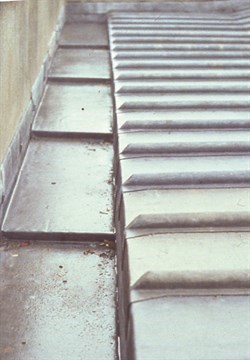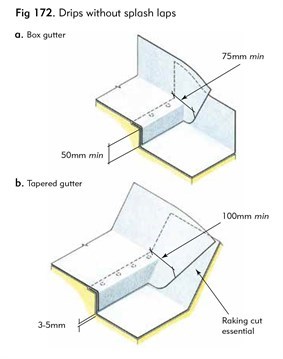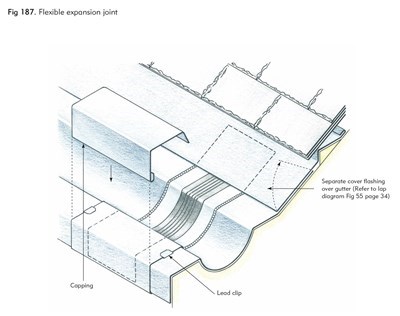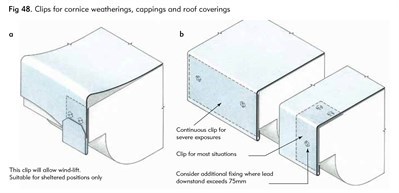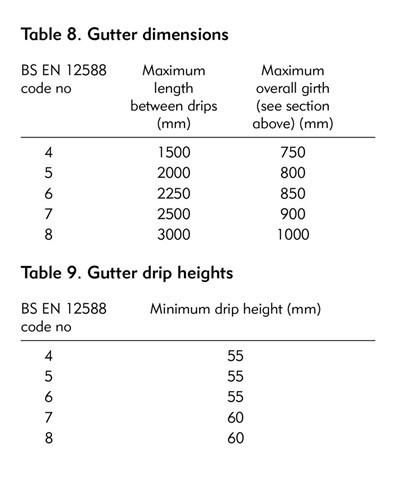The use of rubber expansion joints in lead guttering
[edit] Lead guttering: A flexible approach
A question that is often asked of professionals is about the correct way to fit a lead gutter. Should they be fitted in the traditional way with drips (steps) breaking up the lengths or can rubber expansion joints be used?
[Example of a typical box gutter]
One answer is that if it can be done the traditional way then it should be. However, if the situation means this can’t be done, there may be no choice other than to use an alternative method.
So what is a rubber expansion joint and when should it be used?
To a certain extent, the answer lies in its history. Neoprene expansion joints, to give them their proper name, were first used in Europe in conjunction with zinc and copper gutter linings. The idea being that a method of jointing was needed to take into account the thermal expansion of certain types of metals. Traditional methods for jointing copper gutters, again with steps along its length, could not be easily replicated in zinc as the material is not as malleable.
In the early-1990s, the same principle was introduced to leadwork. The reason for this was that traditional wall head gutters that were made from concrete and lined with lead, which can be found on many older buildings, needed the leadwork replaced.
Traditionally, the lead lining pieces were just lapped and water ingress was inevitable. As it was impossible to create the traditional steps in these installations, neoprene expansion joints were seen as a good solution.
Over the years, these types of joints have been applied in many different gutter situations and appear to be giving a good service life to date. Their popularity has grown given that they can be welded into place much faster than using traditional ‘bossing’ methods to form the drips.
[edit] Why is that a problem?
One of the main reasons that we refer to these as a ‘last resort’ is that they only carry a manufacturers guarantee of 5 - 10 years. Lead on the other hand is expected to give a service life in excess of 60 - 100 years.
Having a component within this that may have a shorter lifespan is an obvious weak point and one that should be avoided if possible. Their use should be restricted to places where there is no choice, as it may restrict any insurance backed guarantees and could, in certain circumstances, lead to costly replacement works which would require full scaffold access.
All leadworks should take into account the anticipated life of the building concerned. Where a shorter service life may be acceptable to a building owner or developer the use of neoprene expansion joints could be considered. By contrast, where maximum service life is required standard traditional details should always be used. If neoprene joints are proposed, this should be discussed with the client and built into any maintenance programme.
All the details used here are from the LSA's Complete Manual, which includes a wealth of detail on installation and specification. Further information and technical support is available at www.leadsheet.co.uk.
This article was written by Darren Tutt, Senior Technical Officer, The Lead Sheet Association
NB: Any detailing provided by the Lead Sheet Association refers to the use of Rolled Lead Sheet to BS EN 12588.
[edit] Related articles on Designing Buildings Wiki
Featured articles and news
Lighting Industry endorses Blueprint for Electrification
The Lighting Industry Association fully supports the ECA Blueprint as a timely, urgent call to action.
BSRIA Sentinel Clerk of Works Training Case Study
Strengthening expertise to enhance service delivery with integrated cutting-edge industry knowledge.
Impact report from the Supply Chain Sustainability School
Free sustainability skills, training and support delivered to thousands of UK companies to help cut carbon.
The Building Safety Forum at the Installershow 2025
With speakers confirmed for 24 June as part of Building Safety Week.
The UK’s largest air pollution campaign.
Future Homes Standard, now includes solar, but what else?
Will the new standard, due to in the Autumn, go far enough in terms of performance ?
BSRIA Briefing: Cleaner Air, Better tomorrow
A look back at issues relating to inside and outside air quality, discussed during the BSRIA briefing in 2023.
Restoring Abbotsford's hothouse
Bringing the writer Walter Scott's garden to life.
Reflections on the spending review with CIAT.
Retired firefighter cycles world to raise Grenfell funds
Leaving on 14 June 2025 Stephen will raise money for youth and schools through the Grenfell Foundation.
Key points for construction at a glance with industry reactions.
Functionality, visibility and sustainability
The simpler approach to specification.
Architects, architecture, buildings, and inspiration in film
The close ties between makers and the movies, with our long list of suggested viewing.
SELECT three-point plan for action issued to MSPs
Call for Scottish regulation, green skills and recognition of electrotechnical industry as part of a manifesto for Scottish Parliamentary elections.
UCEM becomes the University of the Built Environment
Major milestone in its 106-year history, follows recent merger with London School of Architecture (LSE).
Professional practical experience for Architects in training
The long process to transform the nature of education and professional practical experience in the Architecture profession following recent reports.
A people-first approach to retrofit
Moving away from the destructive paradigm of fabric-first.
New guide for clients launched at Houses of Parliament
'There has never been a more important time for clients to step up and ...ask the right questions'
The impact of recycled slate tiles
Innovation across the decades.
EPC changes for existing buildings
Changes and their context as the new RdSAP methodology comes into use from 15 June.






